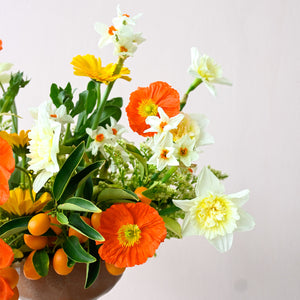Nature often follows the golden ratio in how it arranges growth — not because it knows math, but because it’s efficient, balanced, and beautiful. In floral design, the golden ratio can guide proportion and harmony. Here’s how:
- Using groupings of flowers in Fibonacci numbers (like 3, 5, or 8 stems) can create natural-looking, pleasing clusters.
- Many designers use the golden ratio to decide how tall or wide a floral arrangement should be.
- Placing the focal flower or the visual center slightly off-center (rather than perfectly in the middle) — using the golden ratio — feels more natural and dynamic.
Using the golden ratio in floral design doesn’t mean measuring everything with a ruler — it’s more about tuning into what feels balanced and alive, much like how nature does it. When you echo these natural proportions, your arrangements often feel more organic, more intentional, and more beautiful — even if your audience doesn’t know why.




